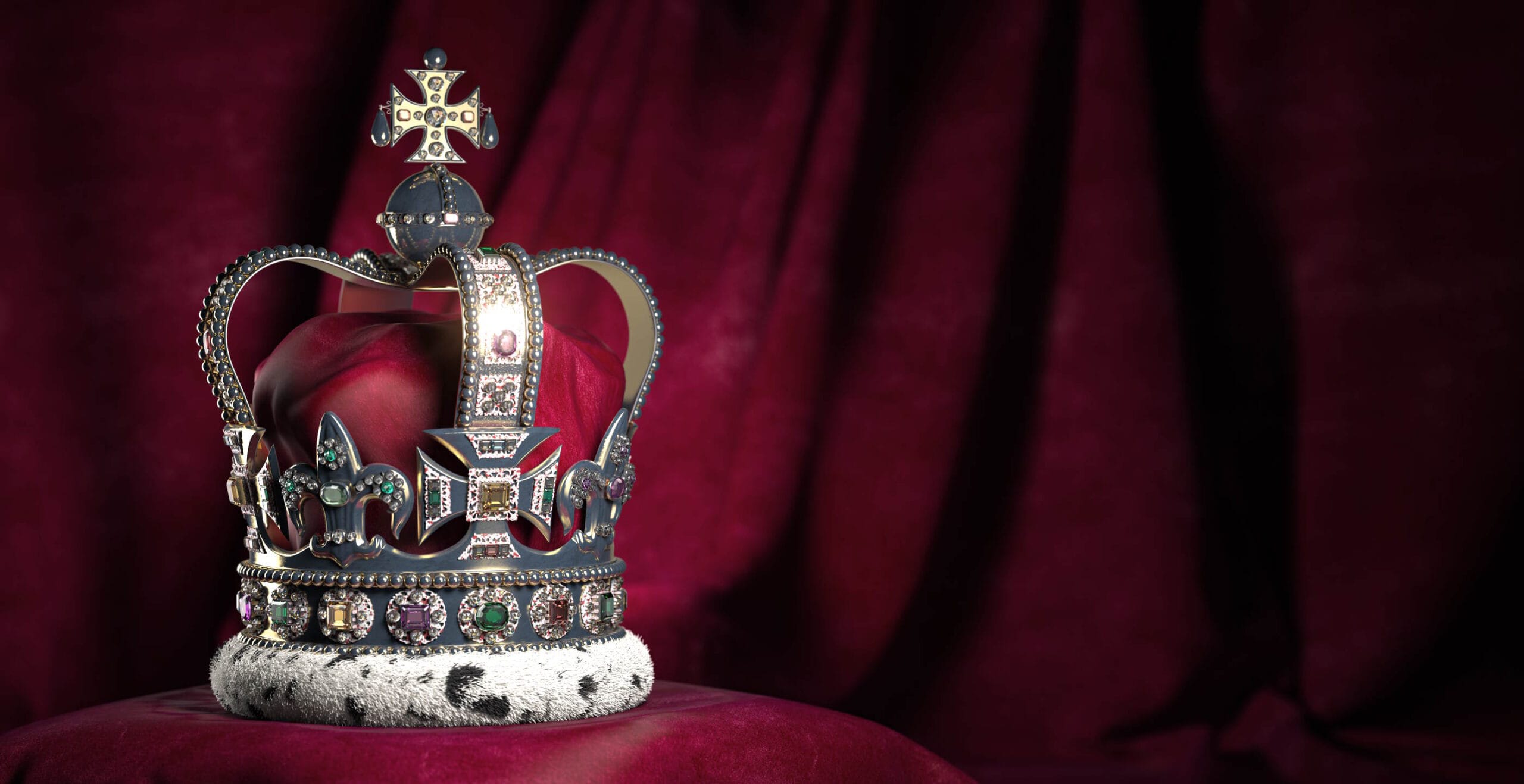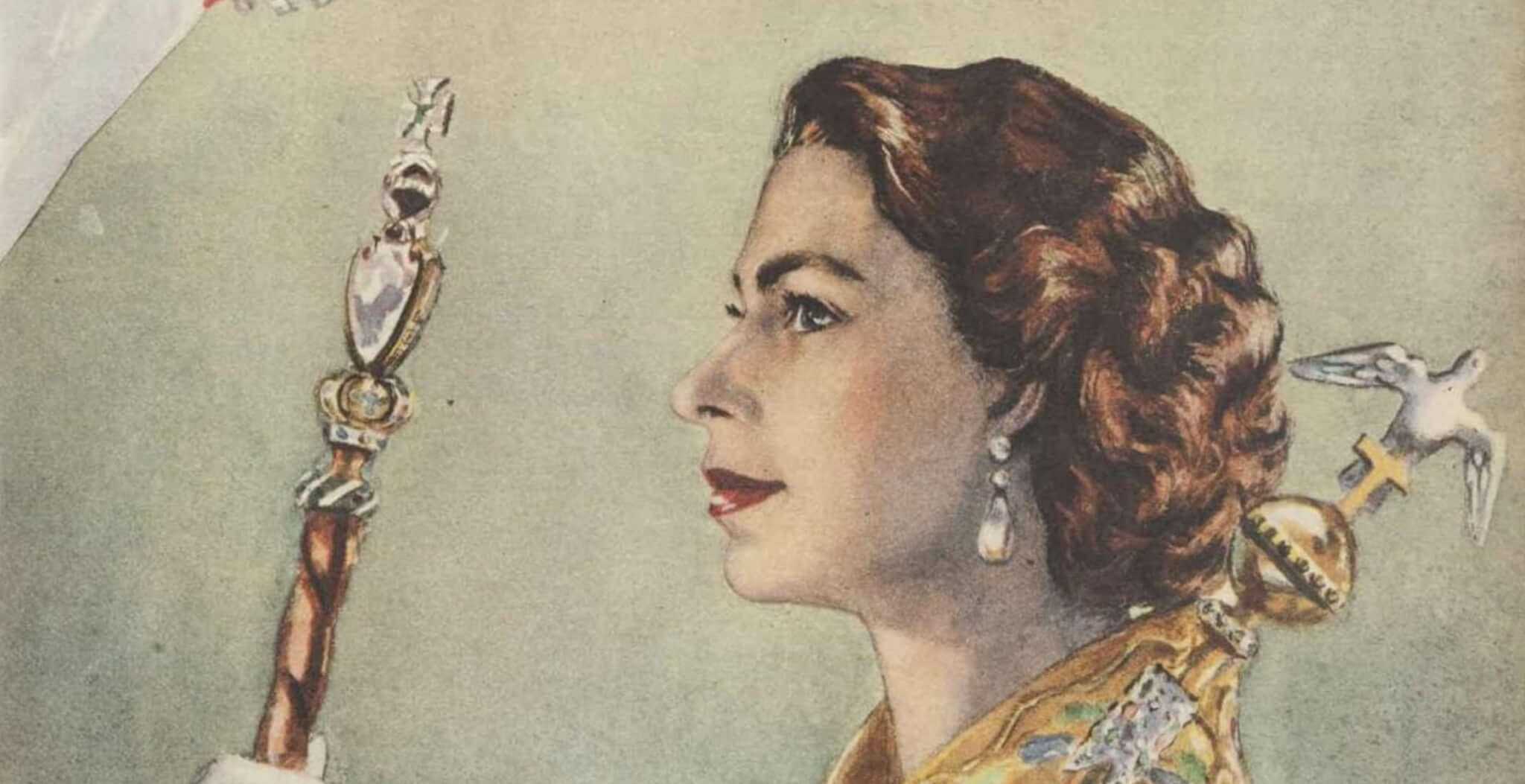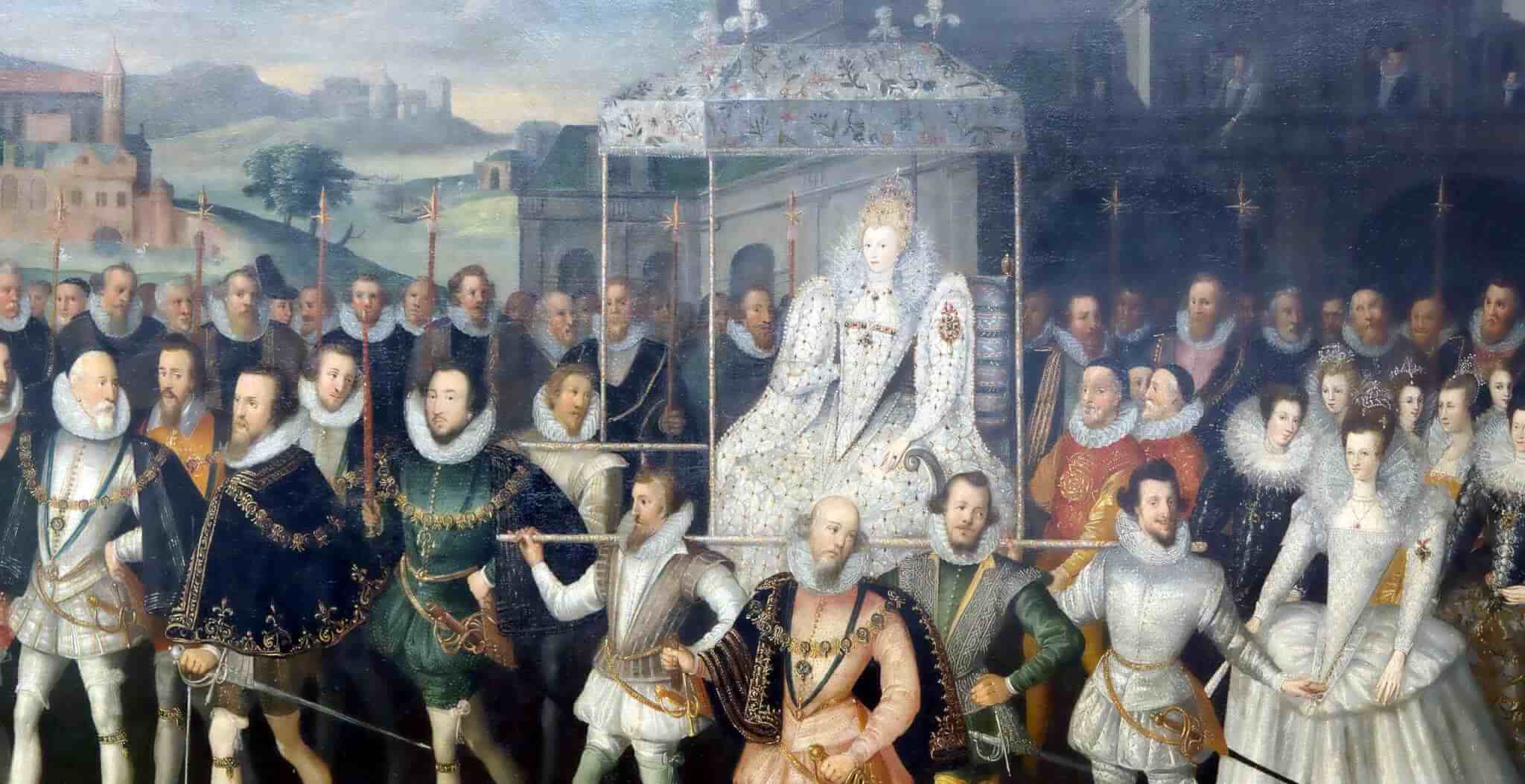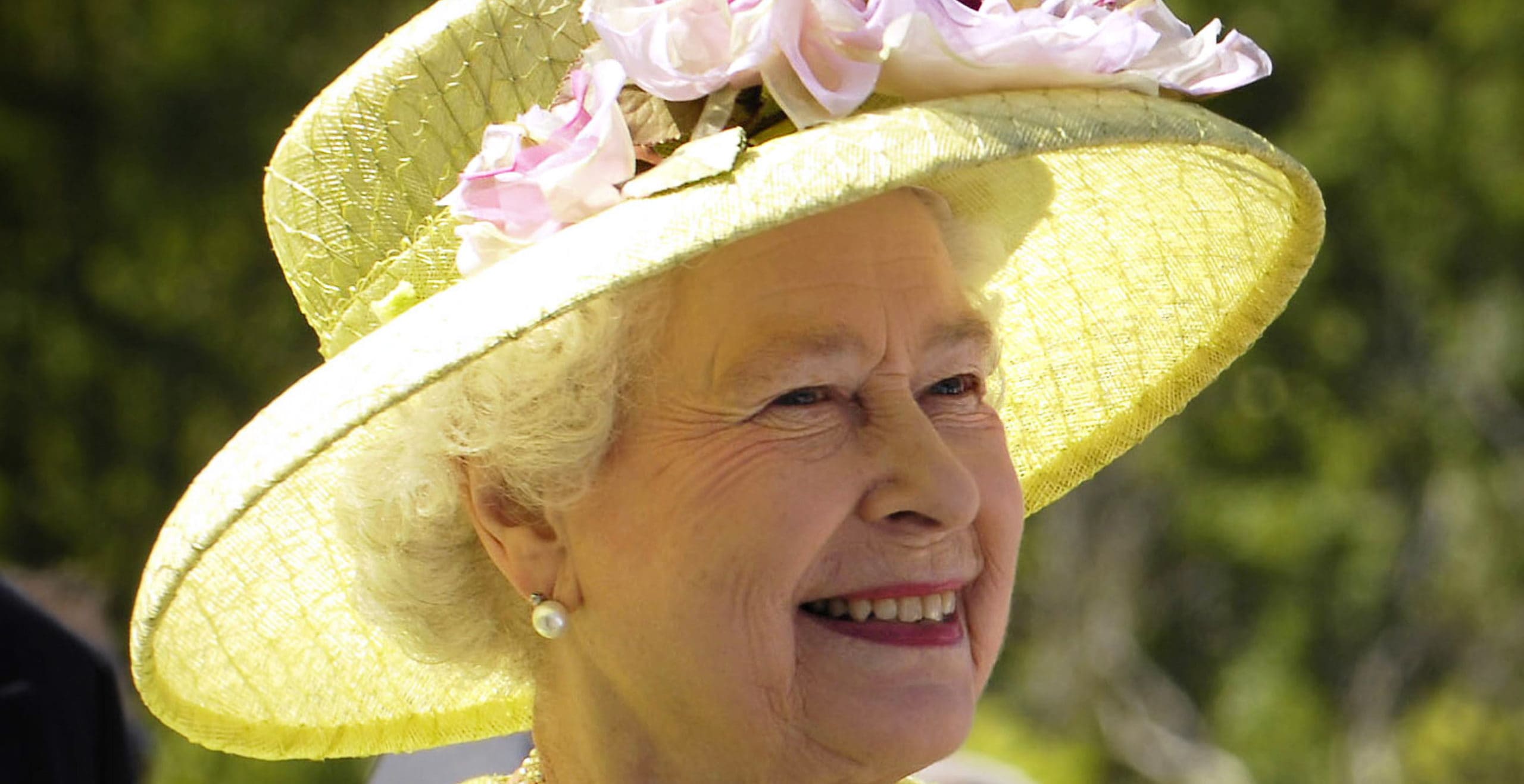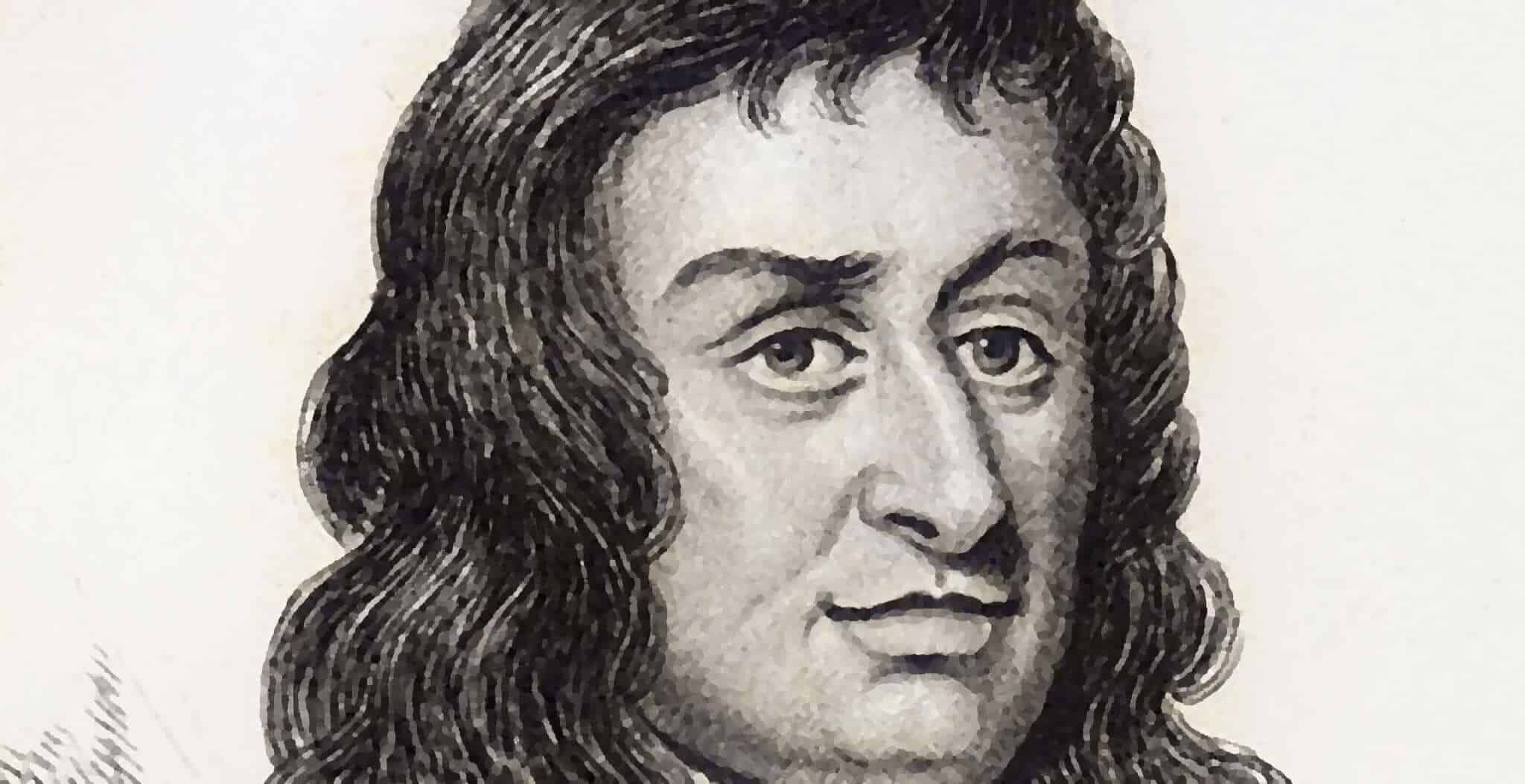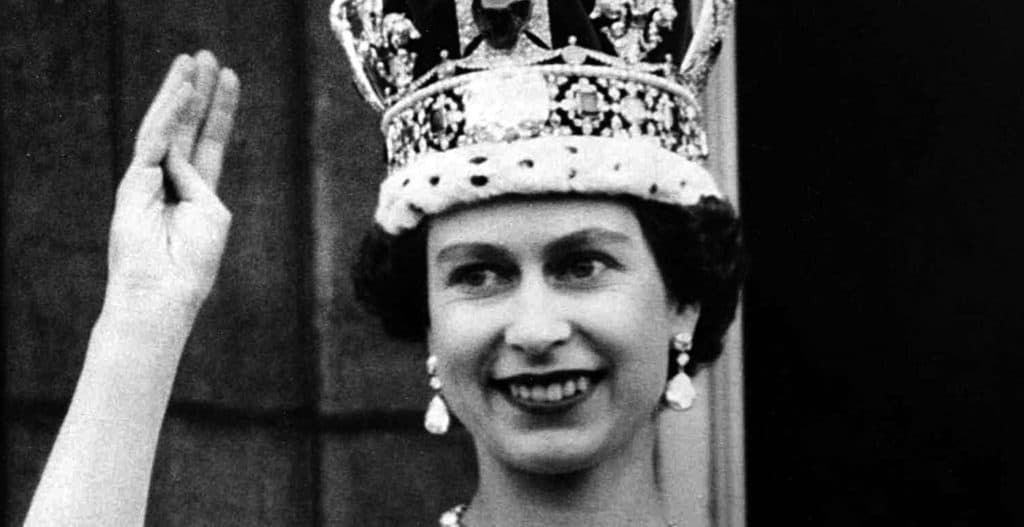On 6th May 2023 the nation will witness its first coronation in 70 years, as King Charles III and Queen Camilla are crowned in Westminster Abbey, London.
At 74, Charles will be the oldest monarch to be crowned in British history.
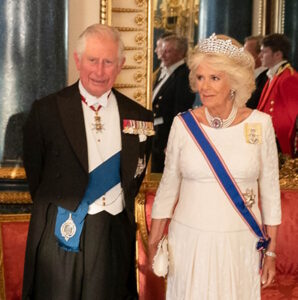
A wonderful display of pomp, ceremony and tradition will accompany the coronation of Their Majesties King Charles III and Queen Camilla. The streets are already lined with Union flags, street parties have been arranged and champagne afternoon teas are ready for the celebration of the first coronation since 1953. It is likely to be shorter and smaller in scale than Queen Elizabeth II’s 1953 coronation. There are expected to be around 2,000 guests in attendance, whereas 8,000 guests were present to witness the late Queen’s coronation in 1953, the first ever to be televised. Then an estimated 27 million people in the UK watched the ceremony on television, with a further 11 million listening on the radio.
The Coronation is a solemn religious ceremony that has remained largely unchanged for over 1,000 years. Since William the Conqueror was crowned on Christmas Day in 1066, the ceremony has taken place at Westminster Abbey. However in 2023, whilst still retaining the ancient Christian ceremony of coronation, the service will also reflect the new king’s role today and will include roles for representatives of other faiths.
The King’s Procession will start at 11am on Coronation Day and will follow a route from Buckingham Palace to Westminster Abbey. The King and Queen Consort will travel in the Diamond Jubilee State Coach, first used in 2014 but they will return in the Gold State Coach which has been used in every coronation since the 1830s. The late Queen is reputed to have said the ride in this coach was terribly uncomfortable and made her feel quite queasy!
King Charles will be wearing military uniform. However, he will also wear a number of ceremonial robes throughout the ceremony, including George VI‘s crimson Robe of State when he enters Westminster Abbey. This is also known as the Parliament Robe as it is worn for the State Opening of Parliament. Camilla will wear the late Queen Elizabeth II’s crimson Robe of State.
Their Majesties will be crowned in the Abbey in London in a service that will be conducted by the Archbishop of Canterbury. There are five distinctive elements to the coronation: the recognition; the oath; the anointing; the investiture and crowning; and the enthronement and homage. After the king is anointed and crowned, Queen Camilla will also be anointed and crowned.
1. The recognition: This dates back to the ancient rites of the Witan who were the high council of England in Anglo-Saxon times. The monarch will be presented to those gathered in the Abbey by the Archbishop of Canterbury, turning to each of the four points of the compass – east, south, west and north – showing himself to the people. The congregation will then shout “God Save the King!” and trumpets sound.
2. The Oath: A specially-commissioned Bible will be presented to the King by the moderator of the General Assembly of the Church of Scotland. The formal presentation of the Bible to the sovereign dates back to the joint coronation of William III and Mary II in 1689.
The king will swear on the Bible to uphold the law and the Church of England. The Coronation Oath Act of 1688 requires the King to declare he will maintain the established Anglican Protestant Church, rule according to laws agreed in parliament, and cause law, justice and mercy to be executed in his judgement. Each part of the oath is framed as a question to the monarch; as the King replies, he places his hand on the Bible.
Out of consideration for Westminster Abbey’s immemorial right to keep the Royal Regalia (now held for greater safety in the Tower of London), on the day before the coronation these precious items will be brought to the Jerusalem Chamber in the Abbey. They will remain there under guard until the ceremony.
3. The anointing: The anointing with holy oil is the central act of the religious ceremony and takes place in private. The King’s Robe of State will be removed as he takes his place in the Coronation Chair, made for King Edward I in around 1301. The chair contains the Stone of Scone (or Stone of Destiny, upon which kings of Scotland were traditionally crowned) which Edward I brought from Scotland in the 13th century. According to legend this block of sandstone from the west coast of Scotland was Jacob’s pillow. The chair has left the Abbey only once since its installation when Cromwell was installed as Lord Protector; however during the Great War it was removed to the Abbey’s crypt for safety.
The king will wear a simple white shirt, called the colobium sindonis, representing that he comes before God as a servant. Over this he will put a golden coat called the supertunica and the coronation girdle around his waist. Both of these robes are of very ancient design: those used by the medieval kings of England were said to have been used by King Edward the Confessor at his coronation in 1043. A gold cloth is held over the chair to conceal the King from view.
The holy oil for anointing the king has been made according to a secret recipe. Charles III’s holy oil was consecrated in Jerusalem and was created using olives harvested from two groves on the Mount of Olives and pressed just outside Bethlehem. It is perfumed with sesame, rose, jasmine, cinnamon, neroli, benzoin, amber and orange blossom.
The Archbishop will anoint the King on his hands, breast and head with oil from the ampulla which is in the shape of a golden eagle. The head unscrews for filling and the oil is poured through its beak. The oil is poured from the ampulla into the coronation spoon, the oldest object in the coronation regalia and probably dating from the 13th century.
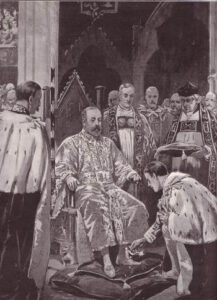
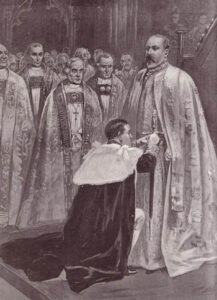
King Edward VII receives the spurs and the sword at his coronation in 1902
4. The investiture: The king will be presented with items including the golden spurs, symbolising knighthood and chivalry, and the sword, made for King George IV‘s 1821 coronation. The sword has a hilt encrusted with diamonds, rubies and emeralds and a jewelled scabbard. It symbolises royal power and knightly virtues.
The sovereign’s ring, the ‘wedding ring of England’ or coronation ring, is a symbol of ‘kingly dignity’. William IV’s ring of 1831 features a large sapphire and diamond cluster with rubies in the form of a cross. There is a legend associated with the coronation ring. As King Edward the Confessor was on his way to the dedication of a Chapel of St John, he was (it is said) approached by a beggar asking for alms. Having no money with him, Edward gave the beggar a ring – large, royal and beautiful – from his finger. The beggar was St John the Evangelist in disguise and the ring was subsequently returned to the Confessor by two pilgrims, with a message that soon he would meet St John in Paradise. The ring used at the Coronation represents this holy relic, which in the Middle Ages, was said to be held in Westminster Abbey.
The king will then be presented with the coronation glove, made for his grandfather George VI. The glove serves as a reminder of holding power, symbolised in the sceptre with cross, gently in a gloved hand.
The Sovereign’s Orb, representing the Christian world, will also be presented to the king and placed in his right hand. It is decorated with clusters of precious stones, surrounded by diamonds and rows of pearls dividing it into three sections, representing the three continents of the world, as known in medieval times. It weighs 1.3kg and dates back to 1661.
The Sovereign’s Sceptre or rod with dove, also called the rod of equity and mercy, is of gold topped with a white enamelled dove, a symbol of justice and mercy. It represents the sovereign’s spiritual role, with the dove symbolising the Holy Ghost.
The Royal Sceptre with cross has been used at every coronation since that of Charles II in 1661 and is the symbol of royal earthly power. For King George V’s coronation the Cullinan I diamond, the largest colourless cut diamond in the world, was added to the sceptre.
The Archbishop will place the Royal Sceptre into the King’s gloved-right hand and the rod into his left.
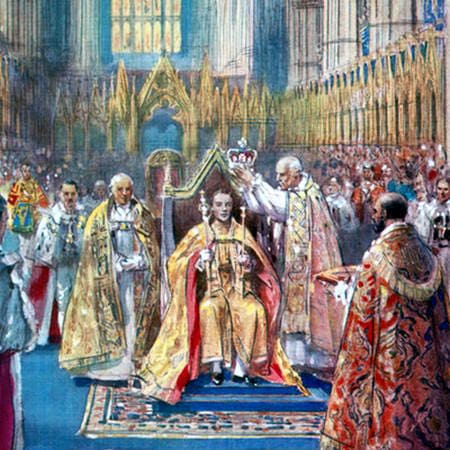
5. The enthroning and crowning
The enthronement represents the monarch taking possession of his kingdom. This ancient ritual harks back to the coronations of early kings who were crowned upon a mound of earth and lifted high on to the shoulders of their nobles for all to see.
The King will be crowned with the 17th century St Edward’s Crown, which is made of solid gold and precious jewels, and is said to be a copy of one that Edward the Confessor bequeathed to Westminster Abbey for future coronations. What was said to be the ancient crown was destroyed by order of Parliament in 1649. St Edward’s Crown is only used at the moment of coronation.
The Archbishop will place the Crown on the King’s head and proclaim: “God save the King!”.
This will be followed by a fanfare in the abbey and the abbey bells will ring out. Gun salutes will be fired at Horse Guards and the Tower of London, as well as other locations across the UK and Gibraltar, and also on Royal Navy ships at sea.
The King will now leave the Coronation Chair and move to the throne. Here his son William, Prince of Wales, will give homage to his father. In a break with tradition, William will be the only blood prince to do so.
Also in a break with tradition, replacing the homage of peers there will follow the homage of the people, whereby people watching around the UK and overseas will be invited to join in by swearing allegiance to the King.
The coronation of the Queen Consort will then take place. Coronation oil is again poured into the ancient spoon and the Archbishop of Canterbury will anoint the Queen on the forehead. For the first time, the anointing will take place in public rather than under a canopy. She will be presented with the Queen Consort’s Ring, a ruby ring made for King William IV’s consort, Queen Adelaide, in 1831. This ring symbolically ‘marries’ the Consort to the King and then to God, in duty and service to the people.
She will then be crowned with Queen Mary’s Crown by the Archbishop of Canterbury. Queen Mary’s crown was made for Charles’s great-grandmother Queen Mary for George V’s coronation in 1911. It is the first time a consort has not had a crown made especially for the occasion.
Queen Camilla will then be presented with the Queen Consort’s ivory rod with dove and the Queen Consort’s sceptre with cross. Camilla will just touch these rather than hold them, as Queen Elizabeth The Queen Mother did at her coronation in 1937.
The King and Queen will then receive Holy Communion. By tradition the coronation takes place within the context of the Christian celebration of the Eucharist (Holy Communion).
Charles and Camilla will then retire to St Edward’s Chapel to change into their purple Robes of Estate and for the King to put on the Imperial State Crown. This crown was made for Queen Victoria and contains the Stuart Sapphire, originally in one of Charles II’s crowns. It also includes the Black Prince‘s ruby, said to have been given by King Pedro of Castile in 1367 and worn by King Henry V at Agincourt in 1415.
The ceremony will conclude with the singing of the National Anthem. The King and Queen Consort will then leave the Abbey for their coronation procession back to Buckingham Palace, riding in the Gold State Coach.
Later the King, Queen and senior members of the Royal family will stand on the balcony of Buckingham Palace for the fly-past.
God Save The King!
Published: 2nd May 2023.
